Page 63 of 345
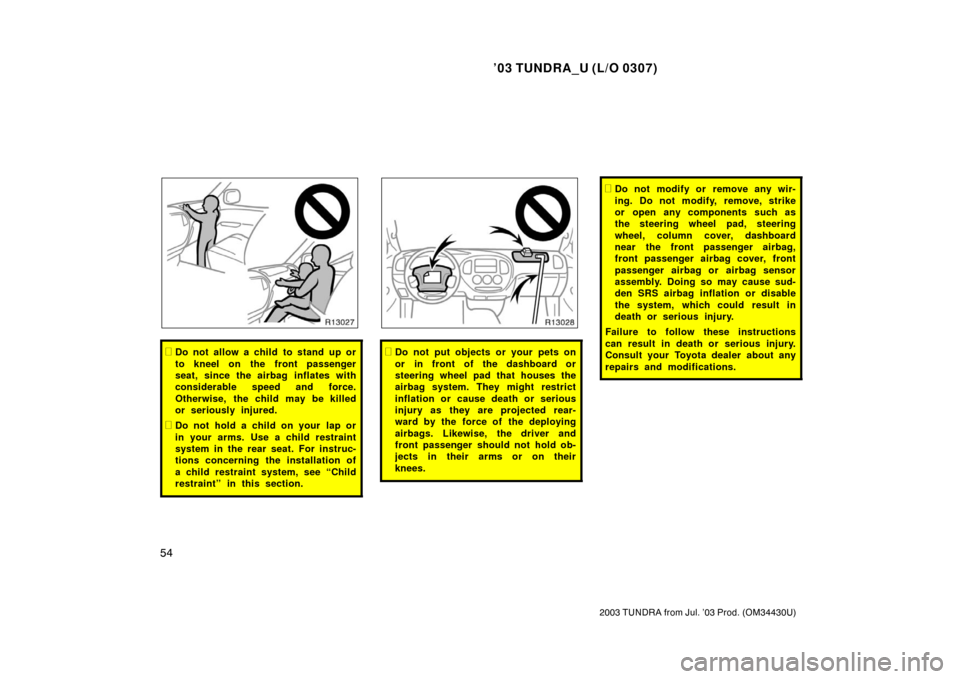
’03 TUNDRA_U (L/O 0307)
54
2003 TUNDRA from Jul. ’03 Prod. (OM 34430U)
�Do not allow a child to stand up or
to kneel on the front passenger
seat, since the airbag inflates with
considerable speed and force.
Otherwise, the child may be killed
or seriously injured.
�Do not hold a child on your lap or
in your arms. Use a child restraint
system in the rear seat. For instruc-
tions concerning the installation of
a child restraint system, see “Child
restraint” in this section.
�Do not put objects or your pets on
or in front of the dashboard or
steering wheel pad that houses the
airbag system. They might restrict
inflation or cause death or serious
injury as they are projected rear-
ward by the force of the deploying
airbags. Likewise, the driver and
front passenger should not hold ob-
jects in their arms or on their
knees.
�Do not modify or remove any wir-
ing. Do not modify, remove, strike
or open any components such as
the steering wheel pad, steering
wheel, column cover, dashboard
near the front passenger airbag,
front passenger airbag cover, front
passenger airbag or airbag sensor
assembly. Doing so may cause sud-
den SRS airbag inflation or disable
the system, which could result in
death or serious injury.
Failure to follow these instructions
can result in death or serious injury.
Consult your Toyota dealer about any
repairs and modifications.
Page 64 of 345
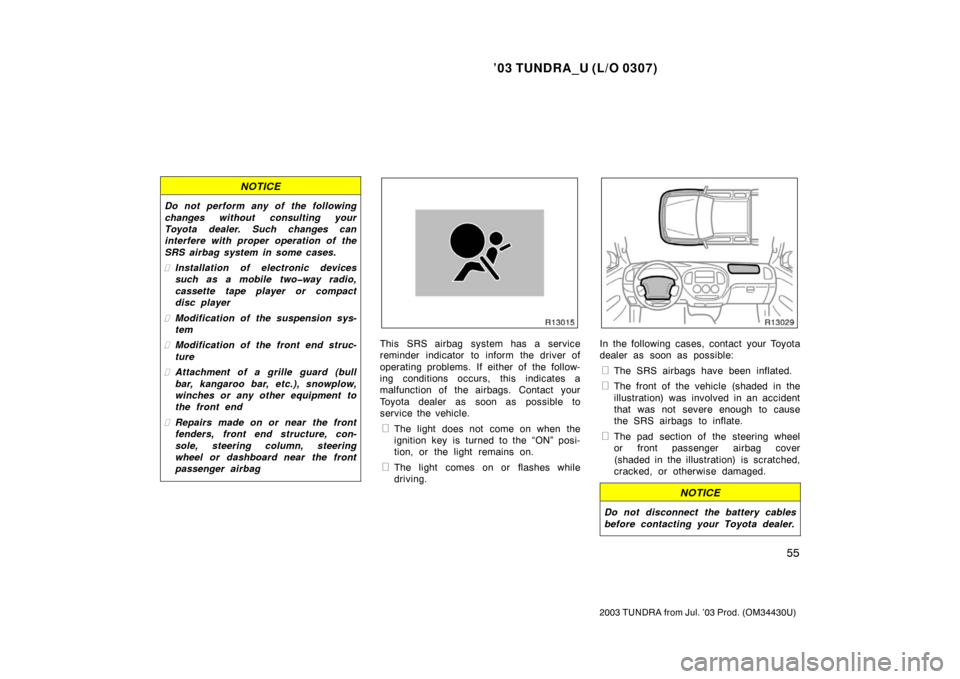
’03 TUNDRA_U (L/O 0307)
55
2003 TUNDRA from Jul. ’03 Prod. (OM 34430U)
NOTICE
Do not perform any of the following
changes without consulting your
Toyota dealer. Such changes can
interfere with proper operation of the
SRS airbag system in some cases.
�Installation of electronic devices
such as a mobile two�way radio,
cassette tape player or compact
disc player
� Modification of the suspension sys-
tem
� Modification of the front end struc-
ture
� Attachment of a grille guard (bull
bar, kangaroo bar, etc.), snowplow,
winches or any other equipment to
the front end
� Repairs made on or near the front
fenders, front end structure, con-
sole, steering column, steering
wheel or dashboard near the front
passenger airbag
This SRS airbag system has a service
reminder indicator to inform the driver of
operating problems. If either of the follow-
ing conditions occurs, this indicates a
malfunction of the airbags. Contact your
Toyota dealer as soon as possible to
service the vehicle.
�The light does not come on when the
ignition key is turned to the “ON” posi-
tion, or the light remains on.
�The light comes on or flashes while
driving.
In the following cases, contact your Toyota
dealer as soon as possible:
�The SRS airbags have been inflated.
�The front of the vehicle (shaded in the
illustration) was involved in an accident
that was not severe enough to cause
the SRS airbags to inflate.
�The pad section of the steering wheel
or front passenger airbag cover
(shaded in the illustration) is scratched,
cracked, or otherwise damaged.
NOTICE
Do not disconnect the battery cables
before contacting your Toyota dealer.
Page 95 of 345
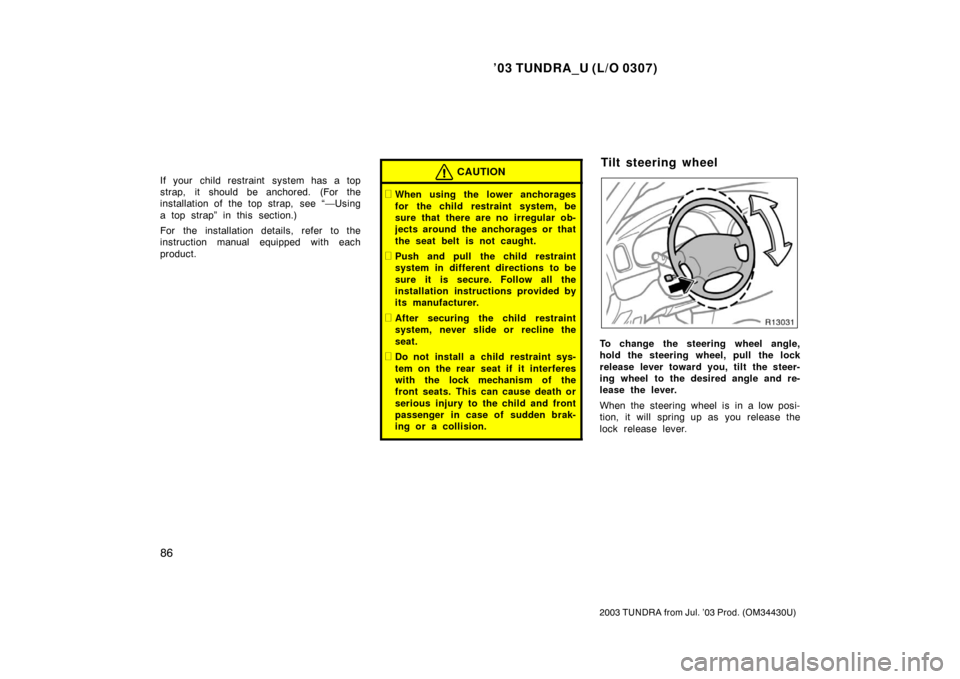
’03 TUNDRA_U (L/O 0307)
86
2003 TUNDRA from Jul. ’03 Prod. (OM 34430U)
If your child restraint system has a top
strap, it should be anchored. (For the
installation of the top strap, see “—Using
a top strap” in this section.)
For the installation details, refer to the
instruction manual equipped with each
product.CAUTION
�When using the lower anchorages
for the child restraint system, be
sure that there are no irregular ob-
jects around the anchorages or that
the seat belt is not caught.
�Push and pull the child restraint
system in different directions to be
sure it is secure. Follow all the
installation instructions provided by
its manufacturer.
�After securing the child restraint
system, never slide or recline the
seat.
�Do not install a child restraint sys-
tem on the rear seat if it interferes
with the lock mechanism of the
front seats. This can cause death or
serious injury to the child and front
passenger in case of sudden brak-
ing or a collision.
To change the steering wheel angle,
hold the steering wheel, pull the lock
release lever toward you, tilt the steer-
ing wheel to the desired angle and re-
lease the lever.
When the steering wheel is in a low posi-
tion, it will spring up as you release the
lock release lever.
Tilt steering wheel
Page 96 of 345
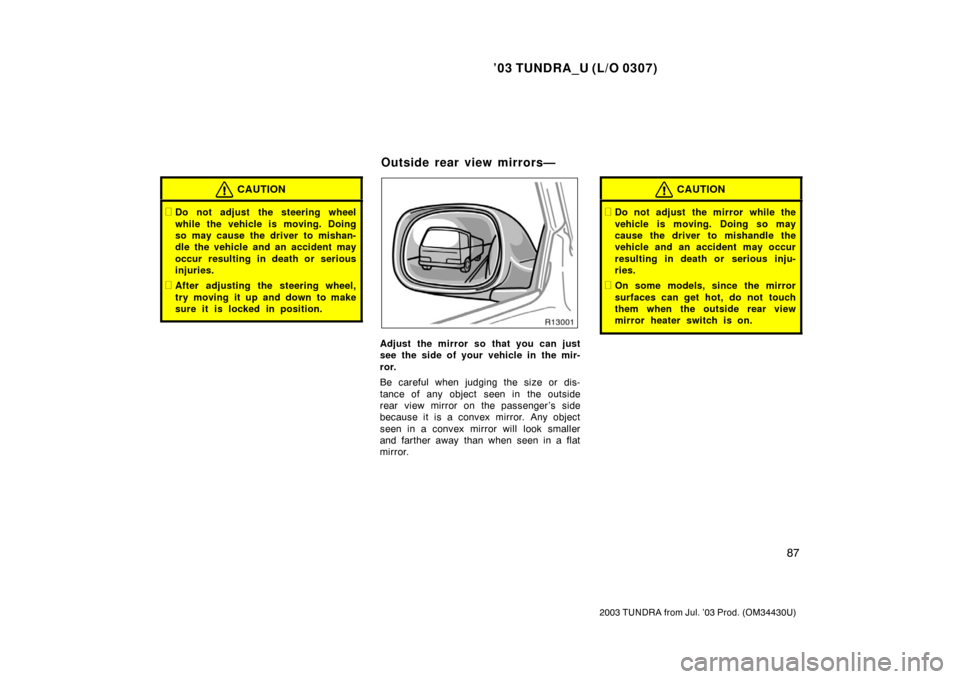
’03 TUNDRA_U (L/O 0307)
87
2003 TUNDRA from Jul. ’03 Prod. (OM 34430U)
CAUTION
�Do not adjust the steering wheel
while the vehicle is moving. Doing
so may cause the driver to mishan-
dle the vehicle and an accident may
occur resulting in death or serious
injuries.
�After adjusting the steering wheel,
try moving it up and down to make
sure it is locked in position.
Adjust the mirror so that you can just
see the side of your vehicle in the mir-
ror.
Be careful when judging the size or dis-
tance of any object seen in the outside
rear view mirror on the passenger’s side
because it is a convex mirror. Any object
seen in a convex mirror will look smaller
and farther away than when seen in a flat
mirror.
CAUTION
�Do not adjust the mirror while the
vehicle is moving. Doing so may
cause the driver to mishandle the
vehicle and an accident may occur
resulting in death or serious inju-
ries.
�On some models, since the mirror
surfaces can get hot, do not touch
them when the outside rear view
mirror heater switch is on.
Outside rear view mirrors—
Page 120 of 345
’03 TUNDRA_U (L/O 0307)
111
2003 TUNDRA from Jul. ’03 Prod. (OM 34430U)
OPERATION OF INSTRUMENTS AND
CONTROLS
Ignition switch, Transmission and Parking brake
Ignition switch with steering lock 11 2
. . . . . . . . . . . . . . . . . . . . . . . . . . . . . .
Automatic transmission 11 3
. . . . . . . . . . . . . . . . . . . . . . . . . . . . . . . . . . . . \
.
Manual transmission 11 7
. . . . . . . . . . . . . . . . . . . . . . . . . . . . . . . . . . . . \
. . . .
Four −wheel drive system 11 8
. . . . . . . . . . . . . . . . . . . . . . . . . . . . . . . . . . . . \
Parking brake 123
. . . . . . . . . . . . . . . . . . . . . . . . . . . . . . . . . . . . \
. . . . . . . . . .
Cruise control 123
. . . . . . . . . . . . . . . . . . . . . . . . . . . . . . . . . . . . \
. . . . . . . . . .
Clutch start cancel switch 126
. . . . . . . . . . . . . . . . . . . . . . . . . . . . . . . . . . . . \
SECTION 1� 6
Page 121 of 345
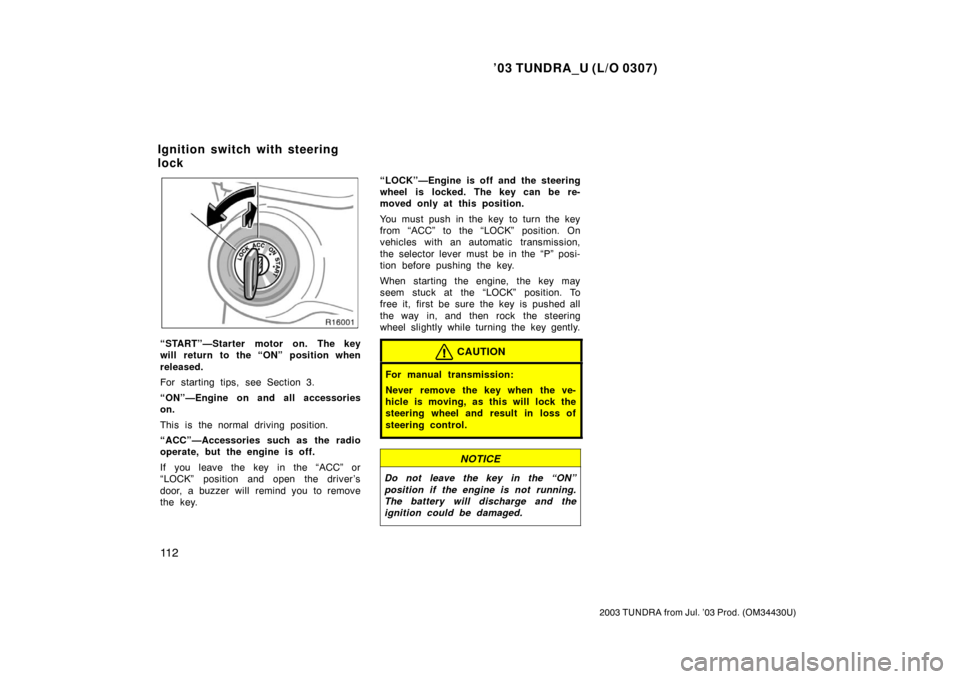
’03 TUNDRA_U (L/O 0307)
11 2
2003 TUNDRA from Jul. ’03 Prod. (OM 34430U)
“START”—Starter motor on. The key
will return to the “ON” position when
released.
For starting tips, see Section 3.
“ON”—Engine on and all accessories
on.
This is the normal driving position.
“ACC”—Accessories such as the radio
operate, but the engine is off.
If you leave the key in the “ACC” or
“LOCK” position and open the driver’s
door, a buzzer will remind you to remove
the key. “LOCK”—Engine is off and the steering
wheel is locked. The key can be re-
moved only at this position.
You must push in the key to turn the key
from “ACC” to the “LOCK” position. On
vehicles with an automatic transmission,
the selector lever must be in the “P” posi-
tion before pushing the key.
When starting the engine, the key may
seem stuck at the “LOCK” position. To
free it, first be sure the key is pushed all
the way in, and then rock the steering
wheel slightly while turning the key gently.CAUTION
For manual transmission:
Never remove the key when the ve-
hicle is moving, as this will lock the
steering wheel and result in loss of
steering control.
NOTICE
Do not leave the key in the “ON”
position if the engine is not running.
The battery will discharge and the
ignition could be damaged.
Ignition switch with steering
lock
Page 159 of 345
’03 TUNDRA_U (L/O 0307)
150
2003 TUNDRA from Jul. ’03 Prod. (OM 34430U)
Some parts of the audio system can be
adjusted using the switches on the steer-
ing wheel.
Details of the specific switches, controls,
and features are described below.
1. Volume control switch
2. “ ��” switch
3. “MODE” switch
Audio remote controls (steering switches)
Page 203 of 345
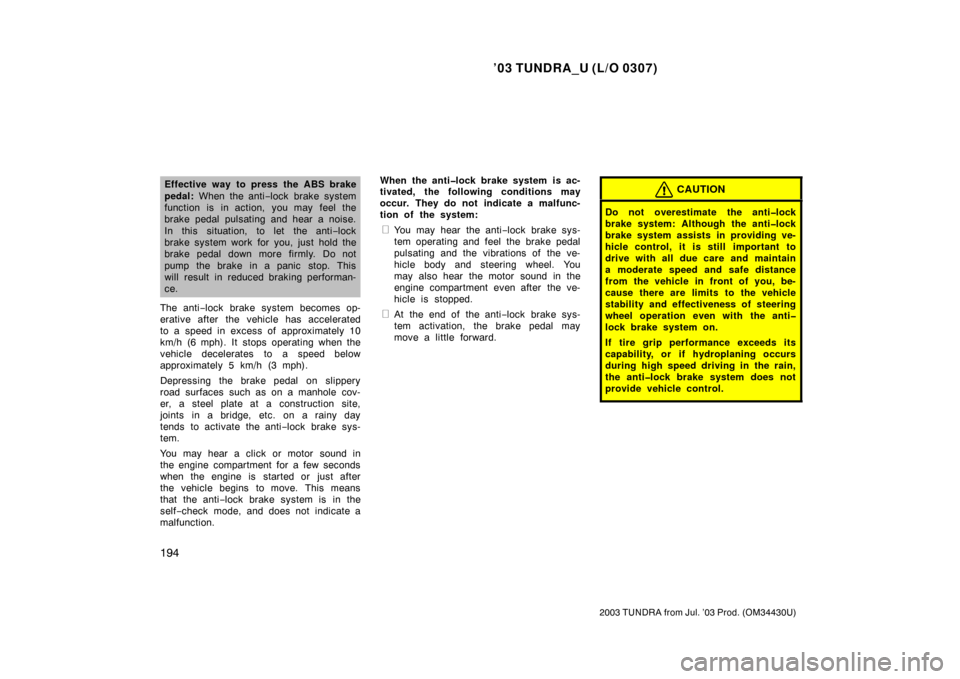
’03 TUNDRA_U (L/O 0307)
194
2003 TUNDRA from Jul. ’03 Prod. (OM 34430U)
Effective way to press the ABS brake
pedal: When the anti −lock brake system
function is in action, you may feel the
brake pedal pulsating and hear a noise.
In this situation, to let the anti −lock
brake system work for you, just hold the
brake pedal down more firmly. Do not
pump the brake in a panic stop. This
will result in reduced braking performan-
ce.
The anti −lock brake system becomes op-
erative after the vehicle has accelerated
to a speed in excess of approximately 10
km/h (6 mph). It stops operating when the
vehicle decelerates to a speed below
approximately 5 km/h (3 mph).
Depressing the brake pedal on slippery
road surfaces such as on a manhole cov-
er, a steel plate at a construction site,
joints in a bridge, etc. on a rainy day
tends to activate the anti −lock brake sys-
tem.
You may hear a click or motor sound in
the engine compartment for a few seconds
when the engine is started or just after
the vehicle begins to move. This means
that the anti −lock brake system is in the
self −check mode, and does not indicate a
malfunction. When the anti�lock brake system is ac-
tivated, the following conditions may
occur. They do not indicate a malfunc-
tion of the system:
�You may hear the anti
−lock brake sys-
tem operating and feel the brake pedal
pulsating and the vibrations of the ve-
hicle body and steering wheel. You
may also hear the motor sound in the
engine compartment even after the ve-
hicle is stopped.
�At the end of the anti −lock brake sys-
tem activation, the brake pedal may
move a little forward.
CAUTION
Do not overestimate the anti�lock
brake system: Although the anti�lock
brake system assists in providing ve-
hicle control, it is still important to
drive with all due care and maintain
a moderate speed and safe distance
from the vehicle in front of you, be-
cause there are limits to the vehicle
stability and effectiveness of steering
wheel operation even with the anti�
lock brake system on.
If tire grip performance exceeds its
capability, or if hydroplaning occurs
during high speed driving in the rain,
the anti�lock brake system does not
provide vehicle control.